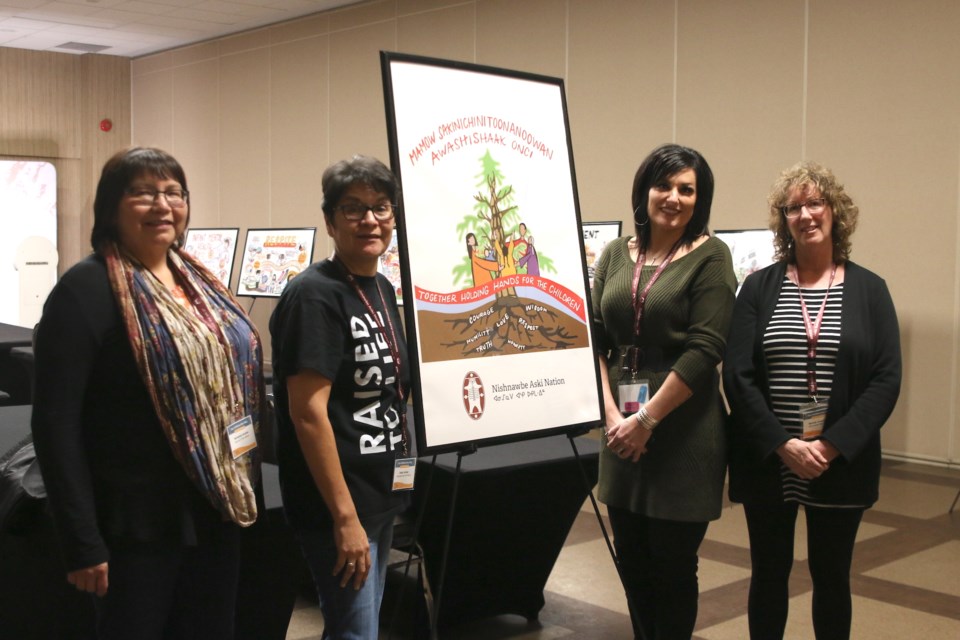THUNDER BAY — Connections to the land and tradition teachings have always existed throughout First Nation communities across the northwest and leaders, educators, and parents in the Nishnawbe Aski Nation territory want to see cultural teachings serve as an integral part of early childhood education.
“The intent today is to really start talking about a vision of changing early learning systems within our First Nations,” said Wendy Arseneault, director of early years department with NAN.
“The western model of providing early learning care is not working and we need to go back to the roots of those values and principles, and teachings of elders in ways of caring for children that are very specific to each community.”
NAN's early years summit opened in Thunder Bay earlier this week and concluded on Thursday. Participants from across NAN communities working in learning fields, day cares, Aboriginal Head Start, and Healthy Babies came together to discuss steps in bringing more cultural and traditional teachings into early childhood development and expanding the services available in remote communities.
According to Arseneault, within the 49 NAN communities, there are only 13 day cares and Head Start programs.
“That’s not sufficient to be able to give every community an opportunity to have that space for early learning,” she said. “We want to push government to support the development and building of new centres and give communities the capacity to do that work.”
During the summit, delegates learned from success stories across the NAN territory, including the Ginoogaming Head Start program that recently opened a newly renovated and expanded facility last February.
Kelly Fortier, a council member of Ginoogaming First Nation, said when she was a young mother, her daughter went through the Head Start program and now her grandchildren are as well.
“Seeing that and having that in our community is a great feeling and a great accomplishment,” she said. “It does help a lot of people on reserve and off reserve, any people who need our services.”
Shelley Franceschini, supervisor at the Ginoogaming First Nation Head Start program, said it provides a safe and nurturing environment for families to learn and further their education.
But updating the space was a long journey, Franceschini added, with the process starting 10 years ago and involved starting from scratch. But she is hopeful other communities can take the lessons they have learned and apply it to developing their own programs.
“It was a great learning curve and learning process and we are grateful for every opportunity we were given to get to where we are,” she said. “Don’t give up. There is going to be opportunities coming and be ready and be excited and get your community involved. If it starts off slow it starts off slow, just keep gaining that momentum and don’t give up.”
According to Arseneault, opportunities through the federal government’s Indigenous Early Learning and Childcare framework provide flexibility in designing early childcare systems.
“We are looking for community-led, community-designed, and community-owned early learning programs very soon in the future,” she said.
A key pillar of early childcare education is traditional and cultural teachings. Micheline Hunter of Peawanuck First Nation said when she returned to her community she saw how important culture is for children as they grow.
“We have been working a lot on that back home to keep our culture, I wouldn’t say alive, it was never gone in our community, it’s just for us to freshen it up,” she said. “We have the tools, we have the knowledge, and we have our elders who are still very knowledgeable.”
Hunter said a lot of traditions and teachings were put aside while Indigenous people were forced into the Residential School system and as a survivor herself, she has learned how to overcome many barriers.
“Now we are focussing on our children because we want them to continue on and to learn more of what they need and what they are seeking to learn,” she said. “There is a lot of sharing happening right now and a lot of information. Going back to those roots, and that’s where it lies, the teachings that we have, the teachings we have out in the land.”
Arseneault added that over the last three days of the summit, it has been heard loud and clear that it is critical for language to be brought back into communities.
“We are losing elders that speak the language and those knowledge keepers and that language needs to be introduced to the children,” she said.
“Our elders spoke over the last two days of the importance of building that self-identity and self-esteem really young and they carry that with them through young adult hood. Knowing their community, their tradition, having that relationship with elders, and always going back to that.”
